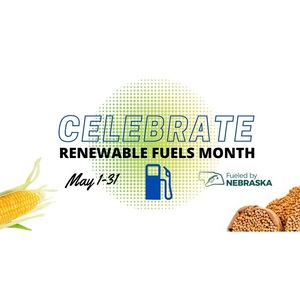Nebraska celebrates Renewable Fuels Month in May

May 1, 2023
BY Nebraska Ethanol Board
Renewable Fuels Month highlights the importance of renewable biofuels, such as ethanol and biodiesel, especially for Nebraskans. The month of May usually marks the beginning of the summer driving season, making it an ideal time to fuel up on clean and cost-saving biofuels.
Both biodiesel and ethanol help to decrease America’s dependence on foreign oil, boost our nation’s economy, and support thousands of jobs in rural communities.
Ethanol is the third largest Nebraska agriculture commodity, and the use of a 10 percent blend saves Nebraskans $275 million per year. Nebraska is also the second largest producer of ethanol in the country.
Biodiesel adds 70 cents per bushel to the value of soybeans. Increased demand for soybean oil to make biodiesel also increases the supply of soybean meal, leading to lower animal feed prices paid by poultry and livestock farmers. Biodiesel can reduce lifecycle emissions by 86 percent compared to petroleum-based diesel fuel. Meanwhile, according to the U.S. Department of Agriculture, ethanol blends reduce greenhouse gas emissions by 43 percent compared to regular gasoline.
“Nebraska agriculture is well-positioned to greatly impact the country’s transition to be less carbon-intensive. While new technologies find their footing, corn and soybeans grown right here in Nebraska will continue to feed and fuel the world for a long time,” said Sherry Vinton, director of the Nebraska Department of Agriculture. “Nebraska is blessed to not only have the land, the tools, and the natural resources for a thriving agriculture industry, but also the farmers and producers who continue to nurture the commodities that, over many decades, have made Nebraska what it is—an agriculture powerhouse. Please celebrate this hard work with us throughout May. Fill up with biofuels, save money, and tell others of the importance of renewable fuels to our state and communities.”
Owners of vehicles 2001 and newer can safely use blends of ethanol up to E15 (15 percent ethanol) and will often enjoy significant savings per gallon. Owners of flex fuel vehicles (FFVs) can use blends up to E85 and experience even greater savings. Heavy-duty diesel vehicles can also lower emissions by filling up with biodiesel blends of 20 percent (B20) or higher. Find locations near you at biodieselne.com.
Fueled by Nebraska, a partnership of Nebraska biofuels organizations, and the Nebraska Soybean Board, invite you to join them to celebrate renewable fuels in your classrooms, at work, and in your community this May. Learn more and find ethanol retail locations at fueledbynebraska.com.
During Renewable Fuels Month, Fueled by Nebraska and the Nebraska Soybean Board will host giveaways, student contests, radio interviews, fuel promotions, and more. To participate, visit facebook.com/fueledbynebraska
Advertisement
Advertisement
Related Stories
Marathon Petroleum Corp. on Aug. 5 released second quarter financial results, reporting improved EBITDA for its renewable diesel segment. The company primarily attributed the improvement to increased utilization and higher margins.
Chevron Corp. on Aug. 1 confirmed the company started production at the Geismar renewable diesel plant in Louisiana during the second quarter after completing work to expand plant capacity from 7,000 to 22,000 barrels per day.
California’s new specified source feedstock attestation requirement: A critical new compliance step for renewable fuel producers
As of July 2025, California’s SCFS requires renewable fuel producers using specified source feedstocks to secure attestation letters reaching back to the point of origin. This marks a significant shift in compliance expectations.
The public comment period on the U.S. EPA’s proposed rule to set 2027 and 2027 RFS RVOs and revise RFS regulations closed Aug. 8. Biofuel groups have largely expressed support for the proposal but also outlined several ways to improve the rulemaking.
The U.S. renewable fuels industry on Aug. 8 celebrated the 20th anniversary of the Renewable Fuel Standard. Federal lawmakers also marked the occasion with resolutions introduced in the House and Senate earlier this month.
Upcoming Events










